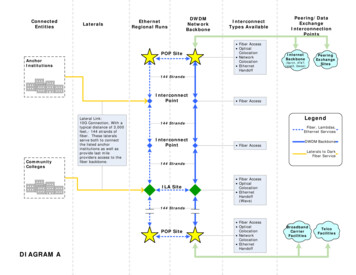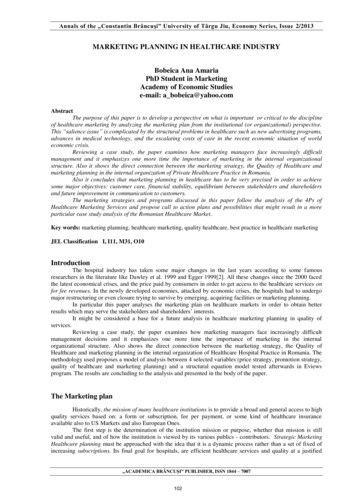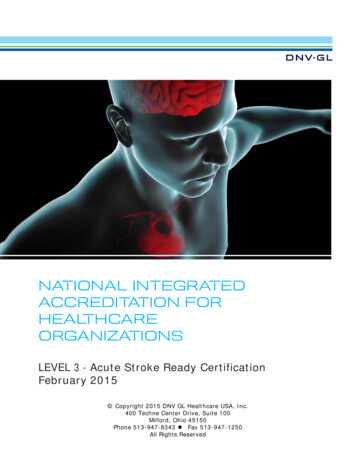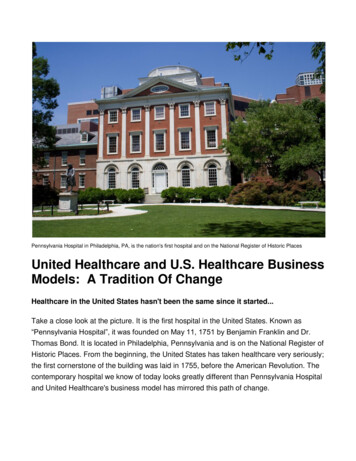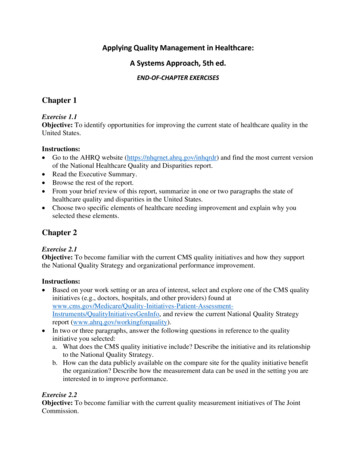
Transcription
Applying Quality Management in Healthcare:A Systems Approach, 5th ed.END-OF-CHAPTER EXERCISESChapter 1Exercise 1.1Objective: To identify opportunities for improving the current state of healthcare quality in theUnited States.Instructions: Go to the AHRQ website (https://nhqrnet.ahrq.gov/inhqrdr) and find the most current versionof the National Healthcare Quality and Disparities report. Read the Executive Summary. Browse the rest of the report. From your brief review of this report, summarize in one or two paragraphs the state ofhealthcare quality and disparities in the United States. Choose two specific elements of healthcare needing improvement and explain why youselected these elements.Chapter 2Exercise 2.1Objective: To become familiar with the current CMS quality initiatives and how they supportthe National Quality Strategy and organizational performance improvement.Instructions: Based on your work setting or an area of interest, select and explore one of the CMS qualityinitiatives (e.g., doctors, hospitals, and other providers) found -AssessmentInstruments/QualityInitiativesGenInfo, and review the current National Quality Strategyreport (www.ahrq.gov/workingforquality). In two or three paragraphs, answer the following questions in reference to the qualityinitiative you selected:a. What does the CMS quality initiative include? Describe the initiative and its relationshipto the National Quality Strategy.b. How can the data publicly available on the compare site for the quality initiative benefitthe organization? Describe how the measurement data can be used in the setting you areinterested in to improve performance.Exercise 2.2Objective: To become familiar with the current quality measurement initiatives of The JointCommission.
Instructions: Explore the current ORYX performance measures of The Joint sures/). For each measure, describe which systemor systems in your chosen setting will be improved by the use of the measure.Chapter 3Exercise 3.1Objective: To practice identifying dynamic complexity.Instructions: Describe how the following example illustrates one or more of the systemcharacteristics that contribute to dynamic complexity.Example: Medical Associates is a for-profit medical group of 40 physicians that operates twofacilities and offers services in several medical specialties, including cardiology; ear, nose, andthroat; family medicine; gastroenterology; general surgery; pediatrics; and obstetrics andgynecology. Medical Associates is open six days a week in each location from 8:00 a.m. until6:00 p.m. Plans are being developed to extend its hours to 9:00 p.m. two days a week. Forseveral years, Medical Associates discounted its listed fees by 3 percent to 5 percent for itsmanaged care contracts, but a few years ago, it had to accept larger discounts to remain in thenetworks of health plans. Because of lower reimbursements (Seidel and Lewis 2017, 217),Medical Associates began to change its staffing by hiring medical assistants (MAs)instead of relying solely on registered nurses (RNs). Currently, all physicians in primarycare service are assigned one RN or MA to assist with patient care, and every twophysicians in surgery are assigned one RN. RNs who retire or resign have been replacedwith MAs. On five recent occasions, when an RN assigned to a senior staff physician left,the senior physician demanded that the RN be replaced by another RN already assignedto a junior staff physician (a nonshareholder) and that a new MA be hired for thatphysician. This ad hoc practice of job switching has caused internal turmoil between thesenior and junior physicians and has led to the subsequent resignation of two RNs whodid not want to be reassigned. . . . Confusion exists around whom staff should report toand who has the authority to change job assignments.Exercise 3.2Objective: To practice identifying activities that represent essential elements in the BaldrigePerformance Excellence Program (BPEP) framework.Instructions: Think about your healthcare services work area or area of interest. Identify twoactivities a manager in this area does to advance organizational excellence in each of thefollowing Baldrige framework categories: StrategyCustomersWorkforceOperations
Examples of what healthcare recipients of the Baldrige National Quality Award have done inthese areas can be found online at www.nist.gov/baldrige/award-recipients.Chapter 4Exercise 4.1Objective: To explore “below the waterline” factors that can impede quality improvements inhealthcare organizations. Managers must recognize whether these factors exist in their worksetting and determine how best to overcome these barriers when initiating operationalimprovements.Instructions: Read the following article:Berwick, D. 2003. “Improvement, Trust, and the Healthcare Workforce.” Quality & Safety inHealth Care 12 (supplement 1): i2–i6. In this article, Dr. Berwick describes several historical and present-day “below the waterline”factors that inhibit healthcare quality improvement. For example, he observes that improvementis limited when the workforce is not encouraged to actively participate in reinventing the system. Identify three factors described by Dr. Berwick that are the most difficult for healthcareorganizations to overcome and explain why.For the three factors you select, describe actions that managers can take to eliminate orminimize the factor so it no longer inhibits operations improvement.Chapter 5Exercise 5.1Objective: To identify practice characteristics that support collective mindfulness.Instructions: Watch the video “Inpatient Medical: Successful Outcome Using TeamSTEPPSTechniques” found at www.ahrq.gov/teamstepps/instructor/videos/ts vig002b/vig002b.html.Identify the practice characteristics exhibited by people in the scenario that contributed tocollective mindfulness (exhibit 5.1). Be specific: describe when and how the practicecharacteristic was exhibited and who exhibited it.Exercise 5.2Objective: To apply equitable results for individuals involved in an adverse event.Instructions: Read the following four case studies. Determine the appropriate results for theindividual who made the mistake.
Case 1: Transport Staff Member Mistakenly Tries to Restrain PatientA patient transport staff member is passing the psychiatric unit and notices a nurse strugglingwith a confused and argumentative patient who was trying to leave the unit. The transporter triesto restrain the patient, but he seizes the patient roughly and fractures several of the patient’s ribs.The transporter realized he had breached procedures as the nurse had not asked for assistanceand nobody appeared to be in immediate physical danger; he also had no training in handlingcombative patients. He admits to his supervisor that he had simply decided to “pitch in” andhelp.Case 2: Housekeeper Mistakenly Overlooks Posting a Wet-Floor SignA housekeeper is waxing the floors near the hospital cafeteria at 1 a.m. He cannot find a wetfloor sign and would have had to go back to the office to find one. He believes there will not beany foot traffic in the area at this time of night, so he does not go to the trouble of finding a sign.He leaves to take his mid-shift break while the floor dries. A young patient who could not sleepwalks with his mother near the vending machine and slips on the wet floor, breaking his wrist.The housekeeping staff often have to search for wet-floor signs, which causes them to get behindin their work. Although the manager is aware of this problem, no additional signs have yet to bepurchased.Case 3: Nurse Mistakenly Omits Double-CheckA nurse is getting ready to administer a high dose of insulin. Consistent with hospital policy, shelooks for another nurse to review her calculation and the amount in the syringe vial, prior toadministration. She is unable to find another nurse and fails to perform the double-check step.The patient receives an overdose of insulin, which results in complications requiring transfer tothe ICU.Case 4: Therapist Mistakenly Ignores Alarm BellA confused patient in a geriatric care unit wanders down the hall and goes out the fire door. Thealarm bell sounds but the physical therapist walking down the hall just ignores it, thinking thatit’s just another false alarm. The patient is later found outside lying on the ground after fallingand breaking a hip.Chapter 6Exercise 6.1Objectives: To practice identifying management behaviors that demonstrate collaborative teamwork andcontinuous improvement.To explore how collaborative teamwork and continuous improvement influence the patientexperience.Instructions: Read the case study, which is drawn from The New Pioneers: The Men and Women Who AreTransforming the Workplace and Marketplace (1999) by former Wall Street Journalcolumnist Thomas Petzinger Jr.
Describe several examples of how management demonstrated the principle of continuousimprovement in the case study.Describe several examples of how management demonstrated the principle of teamwork inthe case study.Describe how your responses to the two previous instructions contributed to the quality of thepatient’s experience (service quality) and the quality of the clinical service (content quality).Case Study: The following section is reprinted with slight changes with the permission of Simon& Schuster Adult Publishing Group from The New Pioneers: The Men and Women Who AreTransforming the Workplace and Marketplace by Thomas Petzinger Jr. Copyright 1999 byThomas Petzinger Jr.While many companies are getting better at customer service, one industry has gotten a lot worselately. That industry is medicine. The onslaught of managed care has commoditized what wasonce the most delicate relationship in all of commerce, that of doctor and patient. Accounting forthe payment of services has overwhelmed the rendering of the services themselves. Yet a fewislands of people have thrown off their Newtonian blinders and recognized that putting thecustomer first can redound to the benefit of the provider as well. With so many competing claimson every dollar, every process, and every hour of time and attention, the interests of thecustomer—the patient—serve as a common ground for making the entire system more efficient.One hospital is such a place: a 520-bed teaching hospital and so-called trauma-one center with astellar clinical reputation. Within the hospital, an outpatient surgery clinic was opened long ago,in which an ever-larger percentage of procedures were being conducted. And although thesurgical staff was acclaimed, management recognized that the overall patient experience leftsomething to be desired.The main problem was delay. The surgery line was jam-packed as early as 5:30 every morning.Some patients spent the entire day lurching from check-in to pre-op to anesthesia to surgery torecovery to post-op, with too much of the time spent simply waiting. As much as some peoplemay wish to convalesce at length as admitted hospital patients, no one wants to turn a four-houroutpatient experience into a nine-hour ordeal. If the hospital wanted to maintain (much lessextend) its position in the marketplace, it had to figure out how to get patients through fasterwithout degrading clinical results.The job of facilitating the planning process went to an internal quality consultant who hadworked for 15 years as a registered nurse, mostly in neonatal intensive care, before earning herMBA and fulfilling this new organizational role. In her years in intensive care, she was oftenperplexed by the priorities that families exhibited in the most dire medical situations. “I’mworking like crazy to save a baby, but the parents get upset because the grandparents didn’t getto see the baby!” she recalls. In time she could see that medicine was only part of healthcare.“Healthcare providers hold people’s lives in their hands at a very vulnerable time,” she says.“Healthcare is about a personal encounter.” Most of the people on the business side of healthcarehave little intellectual grasp and less emotional grasp of this concept. Indeed, after moving to thebusiness side herself, she became convinced that some of the most intractable problems of theindustry could be solved only by people who, like her, combined far-flung disciplines.
“Innovation will come from people who have crossed the boundaries from other disciplines,” shesays—from business to medicine, from medicine to law, and so on.The facilitator insisted on involving the maximum number of nurses— people who knew thewhole patient as well as the individual surgeries they variously received. The new administratorover the area requested that the members of the improvement committee visit as many otherhospitals as possible within their large hospital system to explore which outpatient surgicalpractices could be employed at their own site. And throughout the study process, theadministrator continually harped on the “vision statement” of the initiative, which put as its firstpriority “to provide a patient/family focused quality culture.”This new administrator in the surgery service, a nurse herself, was a powerful force in leadingthe improvement effort. Under the previous leadership, the policy for change was simply “givethe surgeons whatever they want,” as she put it. The administrator acknowledged that thesurgeon must call the shots on procedures—but not necessarily on process. In that respect she,too, insisted on using the patient as the point of departure. “If you’re guided by only onephrase—what is best for the patient—you will always come up with the right answer,” theadministrator insists. (Hearing the administrator and facilitator say this over and over began toremind me of the best editors I have worked for. When in doubt, they would often say, do onlywhat’s right for the reader. Everything else will fall into place.)Studying the surgery line from the patients’ point of view was disturbingly illuminating.Surgeons showing up late for the first round of surgeries at 7:30 a.m. threw off the schedule forthe entire day. The various hospital departments—admitting, financing, lab, surgery—allconducted their own separate interaction with the patient on each of their individual schedules. Apoor physical layout, including a long corridor separating the operating rooms from pre-op,compounded the inefficiencies. Once a patient was called to surgery, he spent 40 minutes waitingfor an orderly to arrive with a wheelchair or gurney. And, because this was an outpatient surgerycenter located inside a hospital, the anesthesiologists were accustomed to administering heavysedation, often slowing the patient’s recovery from otherwise minor surgery and further cloggingthe entire line. The operation was a success, but the patient was pissed.In talking to patients, the researchers discovered a subtext in the complaints about delays:resentment over the loss of personal control. Patients spent the day in God-awful gauze gowns,stripped of their underwear, their backsides exposed to the world. Partly this reflected a medicalculture that considered the procedure, not the patient, as the customer. As the administrator put itto me, “If you’re naked on a stretcher on your back, you’re pretty subservient.” Family members,meanwhile, had to roam the hospital in search of change so they could coax a cup of coffee froma vending machine. She marveled at the arrogance of it. “You’re spending 3,000 on a lovedone, but you’d better bring correct change.”Fortunately, this administrator had the political standing to push through big changes, andalthough the staff surgeons effectively had veto power, most were too busy to get deeplyinvolved in the improvement process. Because few patients enjoy getting stuck with needles, thenurses created a process for capturing the blood from the insertion of each patient’s intravenousneedle and sending it to the lab for whatever tests were necessary. This cut down not only on
discomfort, but on time, money, and scheduling complexity. The unremitting bureaucraticquestions and paperwork were all replaced with a single registration packet that patients pickedup in their doctors’ offices and completed days before ever setting foot in the hospital; lastminute administrative details were attended to in a single phone call the day before surgery. Thenurses set up a check-in system for the coats and valuables of patients and family members,which eliminated the need for every family to encamp with their belongings in a pre-op room forthe entire day. A family-friendly waiting area was created, stocked with free snacks and drinks.There would be no more desperate searches for correct change. That was only the beginning.Patients had always resented having to purchase their post-op medications from the hospitalpharmacy; simply freeing them to use their neighborhood drugstore got them out of the surgeryline sooner, further relieving the congestion. Also in the interest of saving time, the nurses madea heretical proposal to allow healthy outpatients to walk into surgery under their own power,accompanied by their family members, rather than waiting 40 minutes for a wheelchair orgurney. That idea got the attention of the surgeons, who after years of paying ghastly malpracticepremiums vowed that the administrator, not they, would suffer the personal liability on that one.The risk-management department went “eek” at the idea. Yet as the improvement committeepointed out, the hospital permitted outpatients to traverse any other distance in the building byfoot. Why should the march into surgery be any different?In a similar vein, the nurses suggested allowing patients to wear underwear beneath their hospitalgowns. The administrators could scarcely believe their ears: “Show me one place in the literaturewhere patients wear underwear to surgery!” one top administrator demanded. (The nurses notedthat restricting change to what had been attempted elsewhere would automatically eliminate thepossibility of any breakthrough in performance.) And why stop at underwear, the nurses asked.The hospital was conducting more and more outpatient cataract operations; why not let thesepatients wear their clothes into surgery? “Contamination!” the purists cried. But clothing is nodirtier than the skin beneath it, the nurses answered. This change eliminated a major post-opbottleneck caused by elderly patients who could not dress themselves or tie their shoes with theirheads clouded by anesthesia and their depth perception altered by the removal of their cataracts.As the changes took effect, the nurses observed another unintended effect. Patients were actuallyreducing their recovery times! People were no longer looking at ceiling tiles on their way intosurgery like characters in an episode of Dr. Kildare. They went into surgery feeling better andcame out of it feeling better. In case after case they were ready to leave the joint faster; this inturn freed up more space for other patients. Because they had studied practices at a number ofstand-alone clinics, the nurses even suggested to the physicians that the outpatients would bebetter off with less anesthesia, hastening their recoveries, speeding their exit, and freeing up stillmore capacity.Within a year, the volume at the outpatient surgery unit had surged 50 percent with no increasein square footage and no increase in staff. Customer-service surveys were positive and costswere under control. And it dawned on the facilitator that the nurses’ intuitive conviction that thepatient should come first benefited the surgery line itself at every single step. Everyone andeverything connected to the process—surgeon, staff, insurers, time, cost, and quality—seemed tocome out ahead when the patients’ interests came first.
What was really happening, of course, was that the change teams simply put common sense first.In a complex process of many players, the interest of the patient was the one unifyingcharacteristic—the best baseline for calibration— because the patient was the only persontouched by every step.Chapter 7Exercise 7.1Objective: To think about and clarify professional purpose.Instructions: Write your own professional purpose or mission.Practice the purpose principle by writing your responses to the following questions as theyrelate to your professional purpose:a. What am I trying to accomplish?b. What is the process(es) or activity(ies) involved in the response to a? (Be sure to use anactive, not directional, verb.)c. What is the purpose of the response to b?d. What is the purpose of the response to c?e. What is the purpose of the response to d?f. What is my purpose according to my patients, clients, or customers?g. What larger purpose may eliminate the need to achieve this smaller purpose altogether?h. What is the right purpose for me to be working on? Describe how this purpose differs ordoes not differ from my original purpose.Chapter 8Exercise 8.1Objective: To practice linking goal statements with results.Scenario: The quality committee at a hospital reviewed its performance measurement data foracute myocardial infarction (AMI), congestive heart failure (CHF), and pneumonia on theMedicare Hospital Compare website (www.medicare.gov/hospitalcompare). The hospital’sperformance scores for pneumonia and CHF were very similar to the scores attained by hospitalsin the state and throughout the nation. The hospital’s performance on the AMI measures was notas favorable. The results suggest that the hospital approached performance improvements in afragmented, disease-specific manner.Instructions: Consider how organizational goals may have contributed to some improvements incare provided to patients with CHF and pneumonia while improvements in care for patients withAMI lagged. The measures for each of these conditions can be found on the Medicare website(www.medicare.gov). On the following goals worksheet, you will find examples of goalstatements the hospital could have established that would have led to the results described.Critique each goal statement and document your critique on a worksheet such as the one shown
here. Remember, you are critiquing the goal statement, not the merit of the interventionrepresented by the goal statement.Goals WorksheetGoal StatementImprove performance in all the CMS disease-specificindicators.ProsConsEnsure all patients admitted to the ED with the diagnosis ofAMI receive aspirin within minutes of admission.Improve performance on the following AMI indicators: Timeliness of administration of aspirin Prescribing aspirin at discharge Smoking cessation counselingResearch the available clinical guidelines on care of thepatients with AMI, and implement a guideline that demonstrates a strong degree of evidence; ensures meeting all regulatory and payerrequirements; and permits ease of documenting, retrieving, andreporting the necessary performance indicators.Reduce the number of patients with AMI who aredischarged without smoking cessation counseling and aprescription for aspirin.Chapter 9Exercise 9.1Objective: To familiarize yourself with the measurement resources available in the CMSMeasure Inventory Tool.Instructions: Select a healthcare service setting that you are familiar with or would like tobecome more familiar with. Using the search function on the CMS Measures Inventory Tool(https://cmit.cms.gov/CMIT public/ListMeasures), identify measures that could be used in yourchosen setting to evaluate performance in each of these quality domains: safe care, effective care,patient-centered care, timely care, efficient care, and equitable care. Identify at least one measurefor each quality domain.
Chapter 10Exercise 10.1Background: This exercise further explores the principle about data and complex systemsdiscussed in this chapter: “Graphs reveal interesting structures present in the data” (Wheeler2000, 14, 79).Objective: To evaluate graphic presentations of data and select the one that provides the mostvaluable feedback about the system’s behavior.Instructions: As the manager of an ED, you are faced with the challenge of improving flow andbetter matching your staffing plan to patient demand.Like the mammography center manager in this chapter, your monthly reports from the financedepartment present the ED’s volume statistics in a spreadsheet according to this month, lastmonth, year to date, and the same month in the previous year. You decide to graph the data. Youexperiment and come up with the following three graphs using the same information. Select thegraph that provides you with the most insight and explain why you chose that graph.
Exercise 10.2Background: This exercise helps readers learn to identify specific types of data and choose theappropriate graphical techniques and numerical summary measures—critical components ofmaking analytics-driven recommendations.Objectives: The following dataset represents a small portion of a larger report about patientswho visited an urgent care clinic on one day. Identify the type of data found in each column, andidentify the numerical summary measures and graphical methods you would use to summarizethe data in each column.
Instructions: You have been recently hired as the quality manager for an urgent care clinic andwill spend the next two weeks reviewing all the patient records in this dataset. The informationincludes the identification number assigned to each patient, followed by patient age and gender.After this visit, the patients were mailed a survey to gather satisfaction scores. The results arerepresented in the opinion column. A score of 1 is very poor, 2 is poor, 3 is neutral, 4 is good,and 5 is very good. The clinic administrator has supplied the total time each patient spent in theclinic for this visit and the number of prior visits to the clinic for each patient. The billingdepartment has provided the payment type and the charges billed for the visit in the chargescolumn. The patient’s admission blood pressure data come from his or her EHR.The clinic administrator will ask you questions about these data, and your answers will be usedto set performance goals and strategic objectives for the clinic. Considering the small portion ofthe dataset provided previously, answer the following questions:1. What type of data is found in each column (e.g., categorical [nominal]; interval[continuous])?2. Which numerical summary measures would you use to summarize the data in eachcolumn (e.g., mean, median, mode, range, standard deviation)?3. What type of graphical methods would you use to represent the data in each column (e.g.,bar chart, run chart)?Chapter 11Exercise 11.1Objective: To plan a rapid cycle improvement project using the IHI improvement model.Instructions: You will conduct a seven-day rapid cycle improvement project for the followingproblem: Food in your refrigerator is often not eaten by the “best before” date and has to bethrown out. You start the project by answering three improvement questions:1. What am I trying to accomplish?
2. How will I know the change is an improvement?3. What change can I make that will result in improvement?You may choose to record your responses on the Improvement Questions Worksheet that followsor on one similar to it.Improvement Questions WorksheetWhat Am I Trying to Accomplish?Write a short (one or two sentence), generalstatement describing what you want toaccomplish within the next seven days.How Will I Know the Change Is anImprovement?Identify one numerical target for this sevenday improvement cycle, including expectedtime frame ( number of days) for achievingthe target.What Change Can I Make That WillResult in Improvement?Describe one small process change you canimplement and measure in seven days.Exercise 11.2Objective: To practice anticipating unintended consequences.Instructions: For questions a through e, you may choose to record your responses on theUnintended Consequences Worksheet that follows or on one similar to it.a. Select any process that takes place in a health services organization. Write that process inthe center column, column A.b. In column B, identify who (person, group, department, stakeholder) influences theprocess. In other words, think about the activities and people upstream from your process.c. Identify who is influenced by the process in column C. In other words, think about theactivities and people downstream from your process.d. Extend your response one more time. Identify who influences the items in column B.Write your response in column D.e. Identify who is influenced by the items in column C. Write your response in column E.f. Describe one or two unintended consequences created by a change in the processidentified in column A.
DWho influencesthe entries incolumn B?Unintended Consequences WorksheetBACWho influencesthe process?The processWho isinfluenced bythe process?EWho isinfluenced bythe entries incolumn C?Chapter 12Exercise 12.1Objective: To practice creating a project charter.Instructions: Read the case study. Assume you are one of the two directors in the case study,and you are writing a team charter jointly with the other director to address the problemsidentified in the case study. Use the template in exhibit 12.1 or a similar format to document theproject charter.Case Study: The directors of imaging services and surgical services in a hospital are discussingan improvement opportunity involving care provided to patients with breast cancer. The hospitalis encountering delays for procedures involving surgical removal of breast tissue (lumpectomy)in the area where an image-guided core needle biopsy has been performed. During the surgery,the removed tissue is imaged to ensure that the biopsy clip and microcalcifications are present inthe specimen. The imaging must be done with a mammographic
Applying Quality Management in Healthcare: A Systems Approach, 5th ed. END-OF-CHAPTER EXERCISES Chapter 1 Exercise 1.1 Objective: To identify opportunities for improving the current state of healthcare quality in the United States. Instructions: Go to the AHRQ website (https://nhqrnet.ahrq.gov/inhqrdr) and find the most current version

